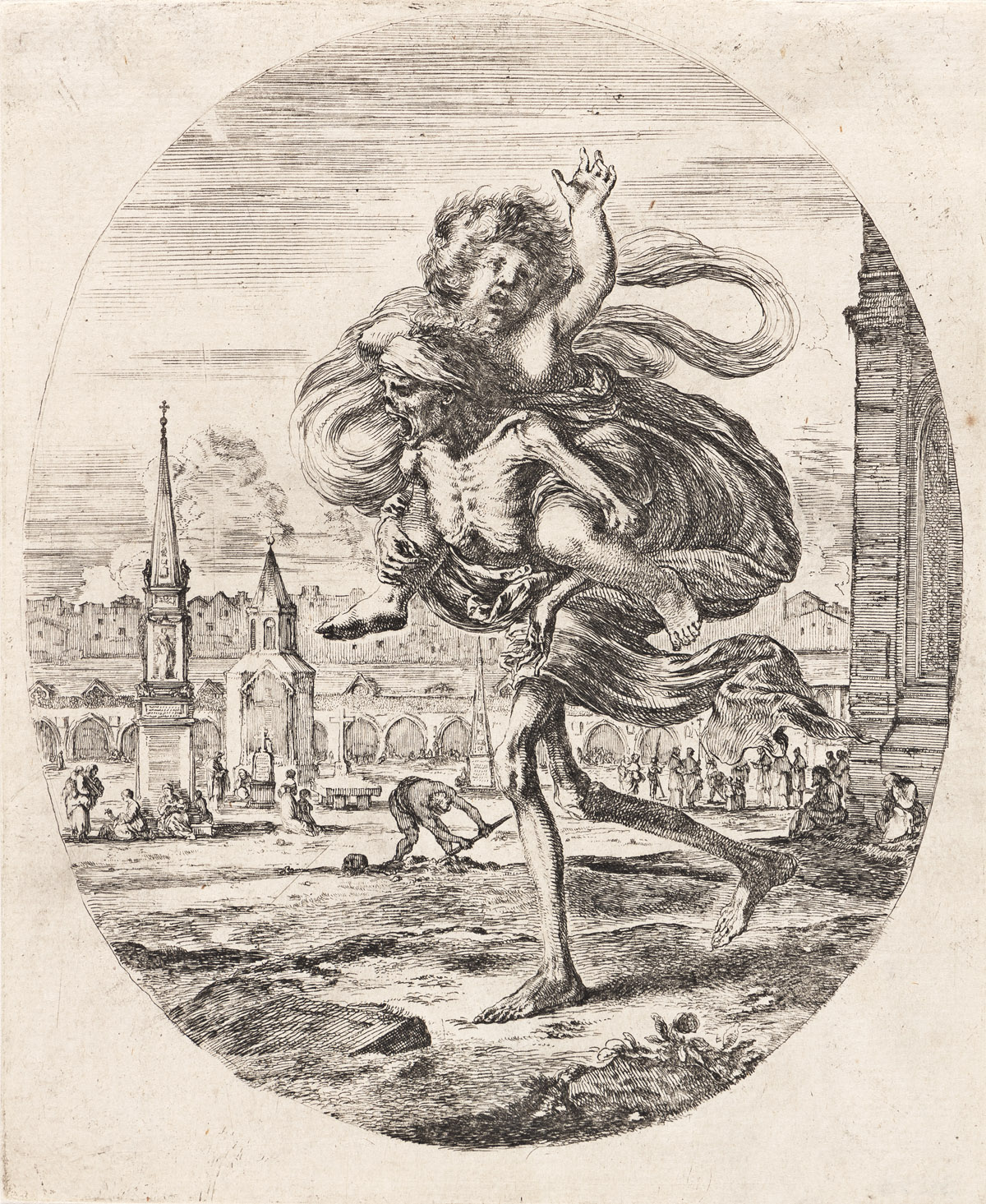ROME 1633 -- [PRINTS]. DELLA BELLA, Stefano. Entrata in Roma dell'Eccel m o Ambasciatore di Pollonia l'anno MDCXXXIII . 1663. Set of six etchings, with margins, save the last which is trimmed to the borderline to facilitate joining the panoramic view of the procession (the first five plates approximately 154 x 420 mm; the last plate approximately 154 x 500 mm). (A few occasional foxmarks, vertical center creases, plates 4-5 with an associated 1½-in. repaired tear, plate 2/3 with a patch in the upper margin with portion of border supplied in manuscript). First state of three, before publisher's address.
ROME 1633 -- [PRINTS]. DELLA BELLA, Stefano. Entrata in Roma dell'Eccel m o Ambasciatore di Pollonia l'anno MDCXXXIII . 1663. Set of six etchings, with margins, save the last which is trimmed to the borderline to facilitate joining the panoramic view of the procession (the first five plates approximately 154 x 420 mm; the last plate approximately 154 x 500 mm). (A few occasional foxmarks, vertical center creases, plates 4-5 with an associated 1½-in. repaired tear, plate 2/3 with a patch in the upper margin with portion of border supplied in manuscript). First state of three, before publisher's address. The entrance of JERZY OSSOLINSKI, Chancellor of Poland and Polish ambassador, to Rome in 1633, dedicated to Lorenzo de' Medici. The first plate includes the title and dedication; the second includes thirty archers; the third and fourth French and Spanish gentlemen; the fifth shows Turkish horses decorated with jewels; and the final plate shows the ambassador accompanied by the Swiss Guard. Jerzy Ossolinski was a Polish szlachcic, Crown Court Treasurer from 1632. The oriental qualities of clothes and arms, and the luxury and wealth implied by the bejeweled outfits, amazed viewers. The march's choreography created colorful effects, including a group of riders dressed in crimson delia of Venetian silk velvet surrounding the envoy. " When Chancellor Jerzy Ossoliéski arrived in Rome in 1633, the event went down in the immortal city's history: he rode in with a hundred horses and camels decked in fabulously rich harnesses, the nobles sitting atop them in their national attire, escorted by exotic prisoners-of-war from the Polish-Lithuanian Republic.s eastern wars. The horses had been shod with golden horseshoes before entering the city, purposefully affixed so that they should fall off, much to the glee of onlookers on the Roman streets. The noble Polish youths tossed gold coins into the crowd, the wings of the Hussars ruffled, and peacock feathers waved. Not even the royalty who visited the Papal capital in those times made such an grand entry" (Krzysztof Mrowcewicz, "Europeans and Samaritans-- Polish Baroque"). He later negotiated with Brandenburgians of Duchy of Prussia in 1635 and led another diplomatic mission to Emperor Ferdinand II and his parliament in Regensburg (Polish Ratyzbona ) in 1636. Massar 44-49; Watanabe 840. (6)
ROME 1633 -- [PRINTS]. DELLA BELLA, Stefano. Entrata in Roma dell'Eccel m o Ambasciatore di Pollonia l'anno MDCXXXIII . 1663. Set of six etchings, with margins, save the last which is trimmed to the borderline to facilitate joining the panoramic view of the procession (the first five plates approximately 154 x 420 mm; the last plate approximately 154 x 500 mm). (A few occasional foxmarks, vertical center creases, plates 4-5 with an associated 1½-in. repaired tear, plate 2/3 with a patch in the upper margin with portion of border supplied in manuscript). First state of three, before publisher's address.
ROME 1633 -- [PRINTS]. DELLA BELLA, Stefano. Entrata in Roma dell'Eccel m o Ambasciatore di Pollonia l'anno MDCXXXIII . 1663. Set of six etchings, with margins, save the last which is trimmed to the borderline to facilitate joining the panoramic view of the procession (the first five plates approximately 154 x 420 mm; the last plate approximately 154 x 500 mm). (A few occasional foxmarks, vertical center creases, plates 4-5 with an associated 1½-in. repaired tear, plate 2/3 with a patch in the upper margin with portion of border supplied in manuscript). First state of three, before publisher's address. The entrance of JERZY OSSOLINSKI, Chancellor of Poland and Polish ambassador, to Rome in 1633, dedicated to Lorenzo de' Medici. The first plate includes the title and dedication; the second includes thirty archers; the third and fourth French and Spanish gentlemen; the fifth shows Turkish horses decorated with jewels; and the final plate shows the ambassador accompanied by the Swiss Guard. Jerzy Ossolinski was a Polish szlachcic, Crown Court Treasurer from 1632. The oriental qualities of clothes and arms, and the luxury and wealth implied by the bejeweled outfits, amazed viewers. The march's choreography created colorful effects, including a group of riders dressed in crimson delia of Venetian silk velvet surrounding the envoy. " When Chancellor Jerzy Ossoliéski arrived in Rome in 1633, the event went down in the immortal city's history: he rode in with a hundred horses and camels decked in fabulously rich harnesses, the nobles sitting atop them in their national attire, escorted by exotic prisoners-of-war from the Polish-Lithuanian Republic.s eastern wars. The horses had been shod with golden horseshoes before entering the city, purposefully affixed so that they should fall off, much to the glee of onlookers on the Roman streets. The noble Polish youths tossed gold coins into the crowd, the wings of the Hussars ruffled, and peacock feathers waved. Not even the royalty who visited the Papal capital in those times made such an grand entry" (Krzysztof Mrowcewicz, "Europeans and Samaritans-- Polish Baroque"). He later negotiated with Brandenburgians of Duchy of Prussia in 1635 and led another diplomatic mission to Emperor Ferdinand II and his parliament in Regensburg (Polish Ratyzbona ) in 1636. Massar 44-49; Watanabe 840. (6)











Testen Sie LotSearch und seine Premium-Features 7 Tage - ohne Kosten!
Lassen Sie sich automatisch über neue Objekte in kommenden Auktionen benachrichtigen.
Suchauftrag anlegen